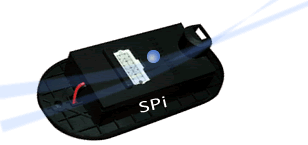Safe Air Start Here!
The Cabin Air Sterilizer continuously removes PM2.5 from inside the vehicle, helping prevent cardiopulmonary diseases.
How do Cabin Air Sterilizer help pevent cardiopulmoary disease ?
The highest filtration grade HEPA (High Efficiency Particulate Air) filter can theroretically filter out dust, pollen, mold, bacteria and any airborne particle with a size of 0.3 microns. On the other hand, the particle size of PM2.5 is 0.1 to 2.5 microns in diameter. Base on IQAIR, "the particle size of UFP (Ultra fine particle) is smaller than 0.1 microns in diamter and about 90 percent of all airborne particles are this size". Therefore, the standard cabin filters found in most vehicles may not be an effective barrier to fine PM2.5 exhaust particles.

The Cabin Air Sterilizer installed behind the vent emits millions of reactive ions per second into the vehicle interior, eliminating PM2.5 particles inside the vehicle in just a few seconds. Ultimately, this helps prevent cardiorespiratory disease.
How does it work?

What is PM2.5 and why is it a health risk?
Case Study of PM2.5 health risk

Cardiovascular effects in patrol officers are associated with fine particulate matter (PM2.5) from brake wear and engine emissions.
Based on PMC (Pub Med, Public Central) data: Exposure to fine particulate matter air pollutants (PM2.5) affects HRV (Heart Rate Variability) parameters, and levels of serum proteins associated with inflammation, hemostasis and thrombosis. This study investigated sources potentially responsible for cardiovascular and hematological effects in highway patrol troopers.
Nine healthy young non-smoking male troopers working from 3 PM to midnight were studied on four consecutive days during their shift and the following night.
CONCLUSION: PM2.5 originating from speed-changing traffic modulates the autonomic control of the heart rhythm, increases the frequency of premature supraventricular beats and elicits pro-inflammatory and pro-thrombotic responses in healthy young men. Data Source: https://www.ncbi.nlm.nih.gov/pmc/articles/PMC1074349/
Perception and reality of particulate matter exposure in New York City taxi drivers.
Taxicab PM2.5 concentrations were elevated compared to central monitoring. Average PM2.5 concentrations per 15-minute interval were 4 - 49 μg/㎥; 1-minute peaks measured up to 452 μg/㎥.
Air pollution exposure among drivers likely exceeds EPA safe level as 35㎍/㎥.
Data Sourece: https://pubmed.ncbi.nlm.nih.gov/27168392/

What level of PM2 5 is considered safe?
National Ambient Air Standards are established to be protective of public health. The short-term standard (24-hour or daily average) is 35 micrograms per cubic meter of air (µg/m3) and the long-term standard (annual average) is 9 µg/m3.
So, PM 2.5 not only correlates to allergy, but it also relates to asthma. Interestingly, when the body receives more PM 2.5, it makes the patient more sensitive to the original allergies and become susceptible to additional new allergies too, which can lead to severe reaction to nasal allergic as well as asthmatic conditions. Data Source: (https://www.bangkokhospital.com/en/content/recurrent-allergy-may-be-caused-by-pm-2-5)
This can be year-round allergy triggers.
Distracted drivers are the top cause of car accidents in the U.S. today. Distracted drivers are quietly causing a staggering amount of serious car accidents. In fact, driver distractions are the leading cause of most auto accidents.